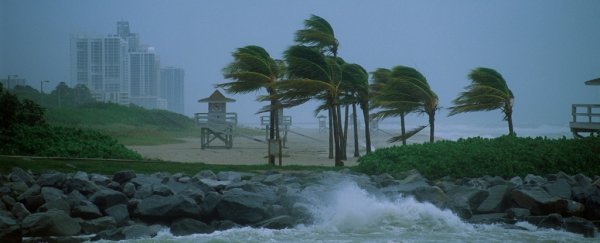The most powerful storms on our planet have grown substantially stronger, and almost forty years' worth of hurricane satellite imagery suggest a warming planet might be fuelling the changes.
According to the data, the likelihood of a hurricane developing into a category 3 storm or greater, with sustained winds of over 177 kilometres per hour (110 miles per hour), has increased by about 8 percent every decade since 1979.
"Our results show that these storms have become stronger on global and regional levels, which is consistent with expectations of how hurricanes respond to a warming world," says climate scientist James Kossin from the National Oceanic and Atmospheric Administration (NOAA).
Climate researchers have long suspected there would be an increase in stronger hurricanes, since warmer ocean temperatures and added moisture in the atmosphere tend to energise these storms.
Real-world data, however, has been trickier to come by. Hurricanes – also known as tropical cyclones and typhoons, depending on where they originate – only appear sporadically, and can be difficult to study. Plus, these storms are often ignored if they don't directly impact upon on humans.
"The main hurdle we have for finding trends is that the data are collected using the best technology at the time," says Kossin.
"Every year the data are a bit different than last year, each new satellite has new tools and captures data in different ways, so in the end we have a patchwork quilt of all the satellite data that have been woven together."
Thanks to computers though, which can help us to interpret satellite images of storms around the world, the team has now shown that from 1979 to 2017 there was a detectable trend toward stronger hurricanes – and this matches up consistently with greenhouse warming simulations.
"It's a good step forward and increases our confidence that global warming has made hurricanes stronger," says Kossin, "but our results don't tell us precisely how much of the trends are caused by human activities and how much may be just natural variability."
Ultimately, the authors admit there are many other factors, other than climate change, that contribute to hurricane intensity. And yet, based on our current understanding of greenhouse warming, there really seems to be a "likely human fingerprint" on these rapid and dangerous changes.
"Through modelling and our understanding of atmospheric physics, the study agrees with what we would expect to see in a warming climate like ours," says Kossin.
Kerry Emanuel, a hurricane expert who was not involved in the study, told The Washington Post that while the hurricane research community may debate over whether hurricanes are slowing down (potentially causing more destruction as a result over land), there's generally more agreement that these storms are bringing greater rainfall with warming oceans.
This new, real-world research, Emanuel says, is a "gratifying confirmation of what the field was concluding anyway… a much more robust indicator that now we're really seeing this in nature".
The study was published in PNAS.
